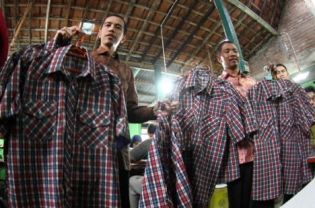
No particular political statement had ever really been promoted through wardrobes. Not until Jokowi-Ahok appeared in their signature red-blue-black checkered shirt, which symbolizes their support for the city’s pluralism and their entrepreneurial spirit, as it is mass-produced by home industries and sold to fund their campaign. (Antara Photo/Akbar Nugroho).
Who would wear a checkered shirt in exchange for a free glass of orange juice? A fried rice vendor in Palmerah, Central Jakarta, would and did. Of course the vendor, who said, “I had to stand in a long line in my checkered shirt,” didn’t mean the exact checkered shirt made popular by Jakarta gubernatorial hopeful Joko Widodo (Jokowi) and running mate Basuki Tjahja Purnama (Ahok). It was actually just a random checkered shirt. Yet his story made me realize how this dress-code strategy has created ripples in the current Jakarta election – from the center stage to the fringes of society.
I always remember electoral campaigns in Indonesia as a parade of boring T-shirts, during which candidates and supporters would wear clothes that matched the colors of their parties. In the case of the Jakarta elections, no particular political statement had ever really been promoted through wardrobes. Not until Jokowi-Ahok appeared in their signature red-blue-black checkered shirt, which symbolizes their support for the city’s pluralism and their entrepreneurial spirit, as it is mass-produced by home industries and sold to fund their campaign. Moreover, they pair it with jeans that mirror their relaxed attitudes. When these men showed up for the first time in this look, I knew I’d see other candidates jump on the dress-code bandwagon due to the instant popularity brought about by this strategy. I was right. It wasn’t long until the campaign trail became a runway for candidates to display their fashion choices.
Duo Hidayat Nur Wahid and Didik Rachbini seems to have made the most effort to outshine Jokowi-Ahok’s checkered shirt. The pair launched their “Batik Beresin Jakarta” (“Let’s Tidy Up Jakarta Batik”). In the color of orange – like Jakarta’s soccer team Persija – the batik bears the design of Monas and the city’s skyscrapers. Backed by the Islam-based Prosperous Justice Party (PKS), Hidayat even emblazoned his Islamic values on his batik, saying the proceeds of the batik sales would be allocated to wakaf (donations for religious purposes). With Betawi’s pucung rebung batik declining in popularity, Hidayat also told reporters, “We’re the only gubernatorial candidate contributing to the cultural heritage through our ‘Batik Beresin Jakarta.’ No other candidate has done this.”
Well, maybe Hidayat didn’t consider the “Si Pitung” style adopted by Hendardji Soepandji and Ahmad Riza as an homage to traditional Betawi culture. In any case, dressing up like a legendary Betawi hero has at least raised the fashion bar in this election, where candidates come out in a Muslim koko shirt with a sarong draped around the shoulders, a black peci and tribal pants occasionally adorned with a traditional big belt. Considering that politicians dress up to relate to their audience, the pair seems to say to the Betawi people: “Hey, we’re one of you!” Only, they have to watch out because incumbent Fauzi Bowo and running mate Nachrowi Ramli are trying to say the same. Yes, it appears that Foke and Nachrowi prefer the Betawi beskap (traditional blazer) with half-folded sarong on their waists – although they sometimes wear koko shirts too. Given that a beskap was originally used by Javanese aristocrats, this pair seems to want to create an image of experienced high-ranking officials.
I remember our office driver complimenting Fauzi as the most gagah (strong and manly) candidate – thanks to the beskap, as we passed the governor’s banner. Yet, at the same time, he also said Fauzi looked arrogant. His statement confirms how a candidate’s appearance can appear intimidating and unapproachable. Perhaps the remaining candidates, Faisal Basri-Biem Benjamin and Alex Noerdin-Nono Sampono, thought about this too, so they went for simple white shirts. While Alex-Nono put on short-sleeve shirts, Faisal-Biem picked the long-sleeve ones. Faisal rolls up his sleeves, though, saying it symbolizes his readiness to work hard. In choosing white, he said, it shows their commitment to fight for a clean government. In terms of grabbing attention, these two pairs might be less noticeable, but in my view, they wanted to blend in and look real. It’s like they’re saying, “We’re not way out of your league.”
Some might say this whole appearance-oriented campaign lacks substance. After all, you should vote based on the plans and programs proposed by the candidates. However, it’s undeniable that fashion can serve as a window to the complex world of politics. We remember how Al Gore chose to wear earth tones in his presidential campaign, as advised by consultant Naomi Wolf, to attract the female votes. Then we have Rick Santorum and his famous V-neck sweater vest in this year’s Republican presidential bid.
All this dressing thing might seem artificial, but any consultant would tell you that memorable appearances can leave a mark in voters’ minds. Or at the very least, it can help voters identify candidates when they’re looking at the ballot. After all, for politicians, it’s the votes that count in the end.
http://www.thejakartaglobe.com/talkback/the-jakarta-election-and-political-fashion-statements/529741
 RSS Feed
RSS Feed
